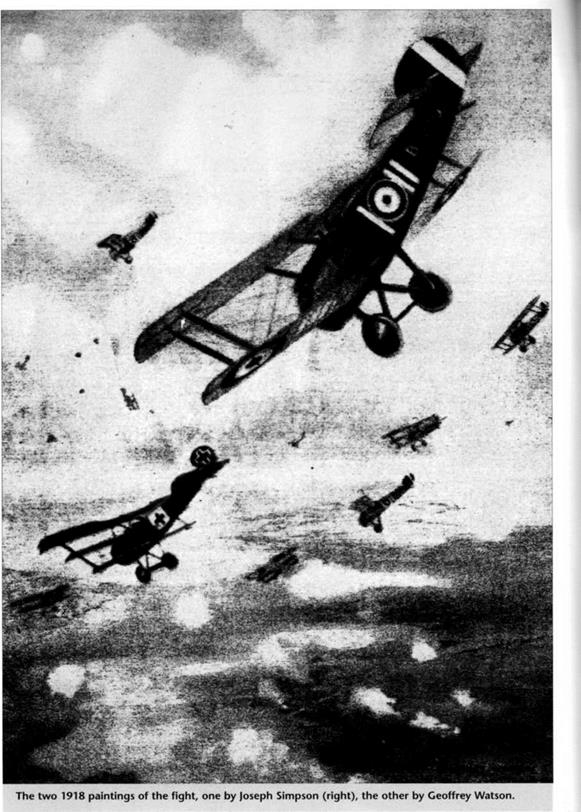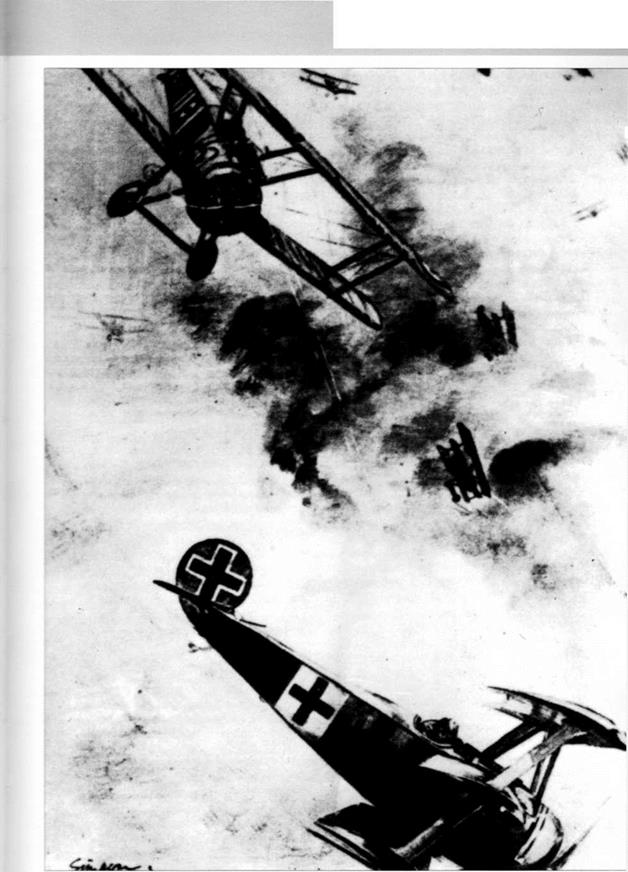APPENDIX A: CABLE’S ACCOUNT
25 May 1918 an account of the end of the Red evil was published in the London (England) Graphic. : was accompanied by the painting of the air fight by ‘■eph Simpson. Boyd Cable was named as the r. tributor. A careful reading will reveal that it is -viously an honest attempt at a true rendering and. г rears to be based upon the account of a 209 Squadron — _-:nber. In its simplicity, it is far closer to the truth than _‘er more detailed efforts by others.
Unfortunately Cable gave no idea of the elapsed me between the events which he described: this ccned a door to much invention. His story may be said і be a skeleton to which others have added flesh, reared sometimes from out of thin air, and which have Transformed what was quite close to the truth, into -.rtual fiction.
Cables account contains one major error and three nor variations from the truth; three of which were to. г pear again and again; sometimes expanded, sometimes -. -^phrased, as later writers added ‘interest’ to the basic • >rv. The major error is treated in Item 4 below. All-in – .2. however, it was a good effort.
The Red Baron, with his famous circus, discovered nro of our artillery observing machines, and with a few followers attached; the greater part of the ‘circus’ drawing off to allow the Baron to go in and down the two. They put up a fight, and, while the Baron manoeuvred for position, a number of our fighting scout machines appeared and attached the ‘circus’.The Baron joined the melee, which, scattering into groups, developed into what our men call a ‘dog fight’. In the course of this, the Baron dropped on the tail of a fighting scout, which dived with the Baron in close pursuit. Another of our scouts, seeing this, dived after the German, opening fire on him. All three machines came near enough to be engaged by infantry machine gun fire, and the Baron was seen to swerve, continue his dive headlong and crash in our lines. His body and the famous blood-red Fokker triplane were afterwards brought in by the infantry, and the Baron was buried with full military honours. He was hit by one bullet, and the position of the wound showed clearly that he had been hilled by the pilot who dived down after him.
Author’s Sotcs:
The attack on the two RE8s was not made by von Richthofen alone. He was accompanied by Leutnant 4ms Weiss. Subsequent elabortions have not copied Cables count; they seem to have leaned the other way rv increasing the number of Triplanes to three or even four.
It should be carefully noted that Cable’s story does. ot have Captain Brown diving to the rescue of the
RE8s. It states correctly that Brown engaged the rest of JGI and that von Richthofen then desisted from attacking the RE8s and rejoined JGI.
2. Cable suggests that Lieutenants Banks and Barrow, the observers in the two RE8s. were reporting the tall of artillery fire. That was not so. They were taking photographs of the German troops and supply concentrations in the Le Hamel area.
3. Cable gives the impression that the machine-gun fire from the infantry occurred at the same time as the second fighting scouts attacked the triplanes (near the bottom of the valley). That was not so. There may have been some rifle fire, but the first machine gunner definitely known at that time to have fired at the Triplane was Sergeant Popkin as it approached the crest of the ridge after climbing up from the valley.
4. Cable shows knowledge of the single bullet but gives its path through von Richthofen’s body as being the reverse of what is known to be true. The wording looks rather like a paraphrase of what is said to have been the opinion of the group of 209 Squadron pilots who, on 2 May 1918. studied the evidence and beliefs, both right and wrong, available to them.
Conclusions
Cable’s 1918 story appears to have been the basis for an anonymous account of the same events published in Canada in 1925. Unfortunately, some of the additions, which considerably distorted the story, had little or no basis in fact, (see Appendix B)
Two famous paintings are worth commenting on. They were both painted shortly after the event and were not influenced by later fanciful writings. Although the background of the Simpson painting (referred to above) is incorrect (it depicts the encounter as being at high altitude), the position of Brown’s Camel relative to von Richthofen’s Triplane should be carefully noted. Brown is shown attacking from the left.
The other 1918 painting, this time by Geoffrey Watson, is worthy of study as well. The background too is incorrect but the attack direction is correct – from the left – as per Brown’s statements.
From 1927 onwards the direction of Roy Brown’s attack, as shown in sketches, drawings and paintings, will be found to be from the right, (see also Appendix D)
NB. Boyd Cable was the pseudonym of Ernest Andrew Ewert OBE. from west London, who wrote several books for John Murray & Co. Ewart was an observer with the RFC and saw service with squadrons at the front for over a year. His stories were fictional but based on facts gleaned while on active service. He ended the war as an acting Lieutenant-Colonel.
|
|
|
|












